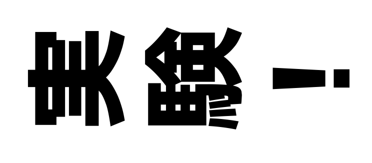SVD
SVD(特異値分解)とは行列を直交行列と対角行列の積に分解する手法であり、次元削減をするアルゴリズムの一種と見ることもできます。ここでは、SVDを使って画像データをより低次元のデータで表現してみようと思います。
import numpy as np
import matplotlib.pyplot as plt
import japanize_matplotlib
from scipy import linalg
from PIL import Image
実験用のデータ
「実験」という文字の画像をデータの系列(グレースケールなので[0, 0, 1, 1, 0 …]のようなベクトルの集まり)に見立てて、特異値分解してみます。
img = Image.open("./sample.png").convert("L").resize((163, 372)).rotate(90, expand=True)
img

特異値分解を実行
## 文字のデータが入った行列Aを特異値分解する
X = np.asarray(img)
U, Sigma, VT = linalg.svd(X, full_matrices=True)
print(f"A: {X.shape}, U: {U.shape}, Σ:{Sigma.shape}, V^T:{VT.shape}")
A: (163, 372), U: (163, 163), Σ:(163,), V^T:(372, 372)
低ランクで画像を近似
# ランクを増やすと元の文字がより精密に復元される
for rank in [1, 2, 3, 4, 5, 10, 20, 50]:
# rank番目までの要素を抽出
U_i = U[:, :rank]
Sigma_i = np.matrix(linalg.diagsvd(Sigma[:rank], rank, rank))
VT_i = VT[:rank, :]
# 画像を復元
temp_image = np.asarray(U_i * Sigma_i * VT_i)
Image.fromarray(np.uint8(temp_image))
plt.title(f"rank={rank}")
plt.imshow(temp_image, cmap="gray")
plt.show()
Vの中身
total = np.zeros((163, 372))
for rank in [1, 2, 3, 4, 5]:
# rank番目までの要素を抽出
U_i = U[:, :rank]
Sigma_i = np.matrix(linalg.diagsvd(Sigma[:rank], rank, rank))
VT_i = VT[:rank, :]
# rank番目の特異値以外をすべて0にして、rank番目の要素のみ残す
if rank > 1:
for ri in range(rank - 1):
Sigma_i[ri, ri] = 0
# 画像を復元
temp_image = np.asarray(U_i * Sigma_i * VT_i)
Image.fromarray(np.uint8(temp_image))
# rank番目の要素のみを足す
total += temp_image
# rank番目までの要素で復元した画像と、行列Vのrank列目の値のプロットを比較してみる
plt.figure(figsize=(5, 5))
plt.suptitle(f"$u_{rank}$")
plt.subplot(211)
plt.imshow(temp_image, cmap="gray")
plt.subplot(212)
plt.plot(VT[0])
plt.show()
# 1~5番目の要素を足し合わせると、ちゃんと元の画像を復元できることを確認する
plt.imshow(total)